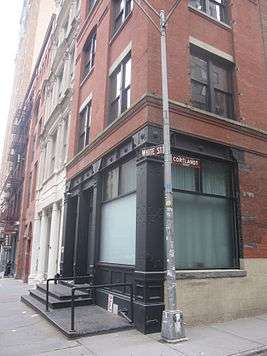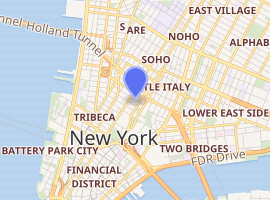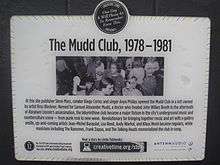Mudd Club
The Mudd Club was a nightclub in the TriBeCa area of New York City, USA, that operated from 1978 to 1983 as a venue for underground music and counterculture events. It was located at 77 White Street in downtown Manhattan and was opened by Steve Maas, art curator Diego Cortez and downtown punk scene figure Anya Phillips.
 Mudd Club building facade in New York City | |

| |
| Location | 77 White Street, Manhattan, New York, United States |
|---|---|
| Coordinates | |
| Owner | Steve Mass, Diego Cortez, Anya Phillips |
| Opened | 1978 |
| Closed | 1983 |

History
The Mudd Club was named after Samuel Alexander Mudd, a doctor who treated John Wilkes Booth in the aftermath of Abraham Lincoln's assassination. It closed in New York in 1983.[1]
To secure the space for the Mudd Club (a loft owned by artist Ross Bleckner), Steve Mass described the future venue as cabaret. Mass claimed to have started the nightclub on a budget of only $15,000.
The club featured a bar, gender-neutral bathrooms and a rotating gallery curated by Keith Haring on the fourth floor.[2] Live performances included new wave, experimental music, literary icons Allen Ginsberg and William Burroughs, and catwalk exhibitions for emerging fashion designers Anna Sui and Jasper Conran.
From the start it functioned as an "amazing antidote to the uptown glitz of Studio 54 in the '70s".[3] As it became more frequented by downtown celebrities, a door policy was established and it acquired a chic, often elitist reputation.
The Mudd Club was frequented by many of Manhattan's up-and-coming cult celebrities. Other individuals associated with the venue included musicians Lou Reed, Johnny Thunders, David Byrne, Debbie Harry, Arto Lindsay, John Lurie, Nico with Jim Tisdall, Lydia Lunch, X, the Cramps, the B-52's, the Bongos and Judas Priest;[4] artist Jean-Michel Basquiat and his then-girlfriend Madonna;[5] performers Klaus Nomi and John Sex; designers Betsey Johnson, Maripol and Marisol; and underground filmmakers Amos Poe; Vincent Gallo, Kathy Acker, and Glenn O'Brien.
Live music at the club featured New York no wave bands like DNA, Nona Hendryx's Zero Cool, the Contortions, and Basquiat's band Gray. In 1979, Talking Heads performed songs from their new album Fear of Music. Tim Page produced several concerts at the Mudd Club in 1981, in an attempt to meld contemporary classical music with rock and pop. On the dance floor, DJs David Azarch, Anita Sarko and Johnny Dynell played a unique mixture of punk, funk and curiosities.
Six months after it opened, the Mudd Club was cited in People Magazine: "New York’s fly-by-night crowd of punks, posers and the ultra-hip has discovered new turf on which to flaunt its manic chic. It is the Mudd Club.... For sheer kinkiness, there has been nothing like it since the cabaret scene in 1920s Berlin".[6]
After its first few years, Studio 54 celebrities like Andy Warhol, Grace Jones and David Bowie began to show up. In 1981, the Mudd Club's Steve Mass began showing up at the more informal Club 57 on St. Mark's Place, and began hiring the Club 57 crowd (including Haring[7]) to help acquire part of that downtown scene.[8]
Mudd Club entry tickets, white with black print, are considered extremely rare because of their simplicity. They entitled the visitor to entry and two drinks.
The Mudd Club closed in 1983. Some regulars noted, "At the end, it was not much fun anymore. I mean, it had just become--kind of like the hangers-on to the hangers-on at the Mudd Club".[9]
The club was mentioned by Talking Heads in their 1979 song "Life During Wartime", by the Ramones in their 1980 song "The Return of Jackie and Judy", by Nina Hagen in her 1983 song "New York / N.Y." and by Elliott Murphy (who performed at the Mudd Club) in his 1983 song "Off the Shelf". Frank Zappa included a song named for the club on his album You Are What You Is.
Mass later opened another Mudd Club in Berlin in 2001 (located at Grosse Hamburger Strasse 17); this Berlin club was considered an intimate venue for touring bands.
In 2007, the arts organization Creative Time placed a plaque on the NYC building to commemorate the club's existence.[10]
On October 28–29, 2010, a 30-year reunion of Mudd Club artists and regulars was held at The Delancey nightclub in Manhattan. Many bands and performers from the Mudd Club and Club 57 performed, including Bush Tetras, Three Teens Kill Four, Comateens and Walter Steading. The Mudd Club reunion was also attended by the two of the three original doormen, Joey Kelly (Buddy Love, Magic Tramps, Dive Bar Romeos) and Richard Boch (author and painter) but not the actor/voiceperson Colter Rule, who was quoted as stating, "I dislike organized partying".[11][12]
The Mudd Club, a memoir by Boch, was published by Feral House in September 2017.[13]
"Catalog" (PDF). processmediainc.com. 2017. Retrieved 2019-06-02.
See also
References
- Blanks, Tim (February 25, 2001). "Mudd Quake". The New York Times Magazine. Retrieved January 13, 2009.
- Gruen, John (ed). Keith Haring: The Authorized Biography, Prentice Hall Press, 1991.
- Musto, Michael. "Farewell, Queen of the Mudd Club," Archived 2009-07-20 at the Wayback Machine Village Voice Le Daily Musto Blog Aug. 17 2008.
- "Rob Halford of Judas Priest handcuffs himself to Andy Warhol, 1979". DangerousMinds. 2018-04-10. Retrieved 2020-07-27.
- Fretz, Eric. Jean-Michel Basquiat: A Biography, Greenwood Press, 2010. Chapter 3.
- People, July 16, 1979.
- Haring, Keith. Keith Haring Journals. Penguin, 1997.
- Hager, Steve. Art After Midnight: The East Village Scene. St. Martin. 1986.
- O'Brien, Glenn. "A Dialogue with Diego Cortez," Jean-Michel Basuiat 1981: The Studio of the Street, Chrata, 2007.
- Kennedy, Randy (April 29, 2007). "Touring Warhol's Space, and 32 Other Art-History Sites". The New York Times. Retrieved May 13, 2010.
- Mudd Club / Club 57 / New Wave Vaudeville Reunion website Archived 2010-09-15 at the Wayback Machine
- Vincentelli, Elisabeth. "Its Name Was Mudd," New York Post, October 23, 2010.
- https://processmediainc.com/wp/wp-content/themes/wpbootstrap/images/fh-2017-catalog.pdf
Sources
- Boch, Richard. The Mudd Club by Richard Boch, published by Feral House 2017
- Musto, Michael. Downtown. Vintage Books, 1986.
- Gendron, Bernard. Between Montmartre and the Mudd Club: Popular Music and the Avant-Garde, University Of Chicago Press, 2002.
- Reynolds, Simon: Rip It Up and Start Again: Postpunk 1978-1984, Penguin Books, Feb. 2006, pgs. 266-267, 278-279.
- Van Pee, Yasmine. Boredom is always counterrevolutionary : art in downtown New York nightclubs, 1978-1985 (M.A. thesis, Center for Curatorial Studies at Bard College, 2004).
- Richard Boch The Mudd Club Book https://www.nytimes.com/2017/08/25/style/mudd-club-doorman-bowie-basquiat.html==External links==
- "Why Are Lines Shorter for Gas Than the Mudd Club in New York? Because Every Night Is Odd There", People magazine, v.12, n.3, July 16, 1979
- Lisa Dawn Gold, , 1980.
- Linda Dawn Hammond, Photos from the Mudd Club, 1979.